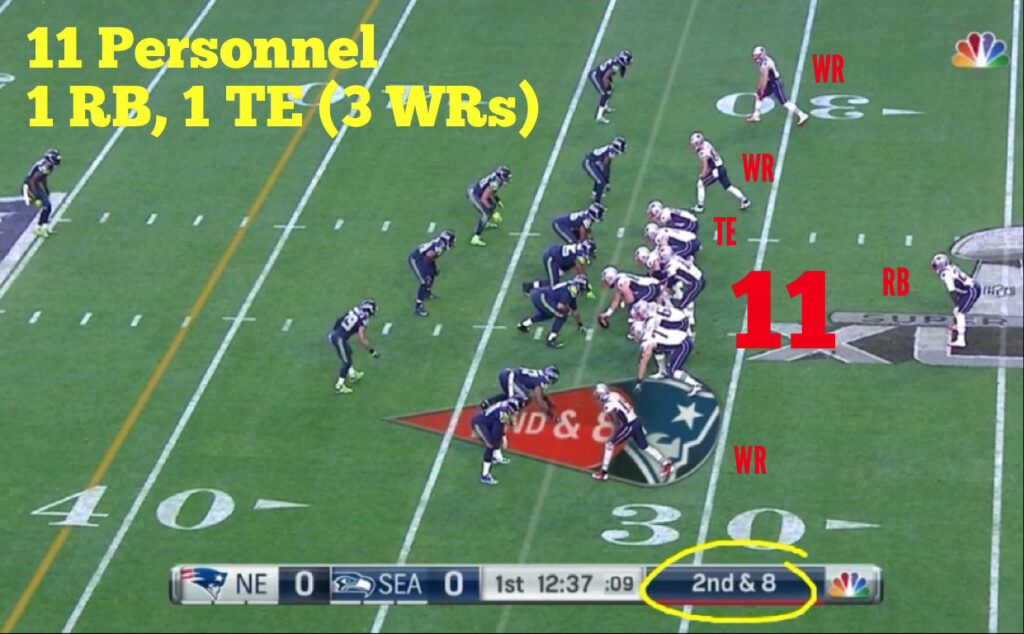How Understanding Personnel Groupings Aids a Defense
This is the second installment of a three-part series discussing how defensive players leverage pre-snap information to gain an advantage over the offense.
If you didn’t catch the first segment about down and distance, you can read it here: http://www.footballbyfootball.com/column/pre-snap-defensive-clues-down-distance.
Down and distance becomes evident as soon as the preceding play concludes.
The subsequent crucial defense information is understanding the opposing offense’s personnel grouping.
In football terminology, “personnel groups” refers to the specific combination of skilled players on the field.

Understanding the personnel grouping on the field serves a dual purpose: it provides a quick reference for identifying eligible receivers in the game, aiding players whose responsibilities may change with a different grouping.
Additionally, it offers insight into the offense’s play-call intentions.
During a defensive huddle, or the ‘muddle’ at the line of scrimmage when the offense isn’t huddling, the down and distance are called out before the play, and the offensive personnel group is echoed throughout the group.
Defensive units in the NFL commonly employ shorthand methods.
One approach involves using playing card labels such as Kings, Queens, Jacks, etc.
Each label represents a distinct combination of wide receivers, tight ends, and running backs.
Another widely used method employs two-digit number labels; you’ve likely heard terms like “21 personnel” or similar during NFL game broadcasts.
These two-digit designations indicate the number of running backs on the field (the first digit) and the number of tight ends (the second digit).
The number of wide receivers is not explicitly stated; it is assumed to be the remaining count of the five eligible players on the field.
For instance, in the case of 21 personnel, there are two wide receivers (5 minus 3).
Apart from 21, today’s NFL’s most prevalent personnel groupings are 11 (one back, one tight end, three wide receivers) and 12 (one back, two tight ends, and two wide receivers).
The Personnel Piece of the Puzzle
As we previously discussed, once a team has identified a select set of down and distance situations that hold significant relevance and reliability, the personnel grouping acts as a second piece of information to validate whether relying on the statistical tendency is a prudent decision.
It’s akin to knowing your date loves to dance but realizing that a funeral is not the appropriate setting.
For instance, let’s consider an extreme scenario: if you come into the game with a tendency clue suggesting that your opponent runs the ball 82% of the time on 3rd and 3 or less.
However, if the offense lines up in 10 personnel on 3rd and 3 (one back, no tight ends, four wide receivers), the tendency is effectively debunked, as 10 personnel primarily indicates a passing formation (lacking a tight end can complicate blocking the defensive front).
Conversely, if you’re aware of the same 82% run tendency on 3rd and 3 and the offense lines up in 21 personnel—a grouping that, let’s say, has a 64% overall run tendency but is much more pronounced with a down and distance filter applied—then the run clue is essentially confirmed.
In essence, down and distance, along with personnel information, act as a system of checks and balances for the defense.
Together, they possess substantial power, whereas individually, they may not carry as much weight.
When used in tandem, these two pieces of information can either significantly strengthen a statistical trend or challenge the initial assumption entirely.
Now, let’s apply these considerations to the following Super Bowl example (outlined below) to illustrate a defense’s decisions based on this combined information set.

It’s 2nd and 8, a situation in the NFL often considered a “get back on track” moment, given that the Patriots fell short on a play needing three or more yards.
Defenses recognize that the offense is now playing catch-up, making a profound and riskier pass less likely, as an incompletion would lead to a 3rd and long situation.
For the sake of this hypothetical scenario, let’s assume the Patriots have a strong track record of success with short-passing plays or runs on 2nd and 8+.
In this case, the distinction between run and pass may not be as critical; the focus shifts more toward determining whether the play will be short or long.
The Patriots present the Seahawks with an 11-personnel package.
While statistically, this grouping may lean towards passing plays, it’s important to note that this is 11 personnel with LeGarrette Blount.
This distinction carries weight statistically, as not all 11 personnel formations are created equal.
The team may employ significantly different strategies when pairing pass-catching Shane Vereen with a group of receivers compared to pairing Blount with the same set of players.
Throughout the practice week, the defensive players would have received two sets of statistics for 11 personnel – one involving Blount and the other involving Vereen.
These statistics are likely to show significant disparities, making it crucial for a player to be aware of them.
The Seahawks are employing press coverage across the board, effectively forming a robust 9-man defensive box against this particular formation, which bodes well for defending against the run.
Conversely, one can envision an alternate scenario with off coverage at a distance of 5 yards, where the defense would be more accommodating to a short pass but would have a head start against a vertical route.
The choice of coverage and defensive front consider two key factors that strongly indicate what’s likely to happen: the down and distance and the specific type of 11 personnel grouping the defense presented with.
Without this combination of information, the defense’s reaction could have been entirely different.
This highlights the significance of maintaining an effective offensive schedule.
When an offense finds itself in situations with limited options, the defense gains valuable insights that lead to pronounced tendency clues.
Additional information tilts the balance in favor of the defense.
Conversely, when the offense is ahead of schedule, it puts the defense on the back foot, potentially nullifying any tendency information gathered during the week of preparation.
In a tendency-driven defensive play-calling approach, having this dual-layered information—a robust down and distance tendency coupled with a specialized personnel group tendency—creates an ideal scenario.
It allows the defensive calls to address particular aspects rather than attempting to cover every possible offensive option.
As the second layer of information, the personnel group data can challenge a prior assumption based solely on down and distance, preventing misguided decisions or actions.
From a player’s perspective, it’s advisable to enter a game with roughly 3 to 5 highly reliable tendencies – the go-to strategies you can confidently count on to give you an advantage on a play.
With all the defensive play-call responsibilities to remember, narrowing down the list of actionable tendencies allows most players to keep things clear in their minds amidst the intensity of the game.
Before every play, the down and distance, as well as the personnel grouping, are communicated on the field.
This provides a moment to collect your thoughts, assess the situation in front of you, and consider if there’s an opportunity to anticipate and gain an edge over your opponent.
*Tomorrow, we’ll delve into the third and final fundamental piece of the tendency puzzle: the formation.

